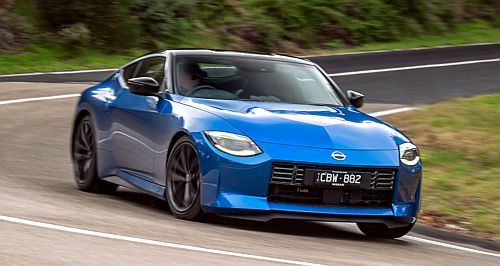Make / Model Search
News - NissanADR changes needed in wake of NVES: NissanNew Nissan MD says speed to market could improve by changing vehicle type approvals20 Jun 2024 By MATT BROGAN NISSAN Oceania’s new vice president and managing director Andrew Humberstone said he believes that shortening type approval processes for new vehicles from 20 to six months would allow car-makers to more quickly respond to legislative changes, bringing more efficient vehicles to market in a timely manner.
Speaking with Australian automotive media at the launch of the updated Nissan Patrol Warrior by Premcar, Mr Humberstone said that major OEMs would be more capable of bringing vehicles to market more quickly were the Australian government to synergise vehicle type approvals with markets whose standards largely reflect our own.
“It is a very interesting situation that this market faces, and from my point of view, it’s all about speed of migration of data, how quickly information comes and how quickly we can adapt,” he said.
“We are arguably one of the OEMs that is at the forefront of electrification technology. The question is ‘how quickly can we bring it into market?’.
“So, our request of the Australian government is, given the change in the actual timeline of the NVES, is to support all OEMs with revisiting the vehicle type approval. At the moment, the process takes around 20 months, when you arguably have cars that are ready to come here.
“We can meet your deadlines if the type approval allows us to bring these products in advance – and bearing in mind these products are coming from very high safety (standard) and major global markets from significant OEMs.”
The request takes an obvious shot at ADR approvals that once served to protect Australian vehicle production.
With that now a thing of the past, Mr Humberstone said it was time for importation processes to be reevaluated in the interest of getting the latest vehicle technology to local customers in the shortest time possible while ensuring nothing is omitted from a vehicle’s specification.
“Nothing would change – only speed. We would of course need to ensure that we meet with legislation, but it would mean we have a fair competitive advantage in the market,” he continued.
“One needs to look at the timelines. The goal posts have been moved significantly (with the introduction of NVES) so it’s our ability to respond to the move in the goal posts.
“We are happy to adapt. From our point of view, we are arguably ready – more ready than a lot of other OEMs – given where we are in Europe and where we are in terms of our global electrification strategy.
“All we are asking is that if you’re able to accelerate the legislation, can you accelerate the process which allows us to bring the cars in and we will match.”
Noted as an area of particular concern – and an obvious sticking point for many imported vehicles – is ADR 34, the regulation governing the fitment of a top-tether child seat anchor point.
Introduced in 1986, the mechanism for affixing child seats is now largely superseded by ISOFIX and other similar designs in other major markets but remains a hurdle for vehicles imported into Australia.
“We are talking about type approvals from major global market. Vehicles that, for example, are approved for the UK and meet UK spec,” added Nissan Australia general manager of corporate communications Emily Fadeyev.
“Direct acceptance of type approvals from major markets would make the centre top tether point optional for passenger cars, as it currently is in dual-cab utes for example.
“This would allow OEMs to either bring overseas spec vehicle to market more quickly or provide a centre top tether in segments where customers want to put three child seats across the second row.
“Importantly, there is no compromise on safety. The road rules prohibit installation of a child seat with a top tether in a seating location without an actual top tether.”
Mr Humberstone said the matter should be raised with government to understand how changes to the current process would see appropriately specified vehicles reach Australian showrooms more quickly – giving major OEMs a competitive advantage under NVES.
“I think the point here is that this is under discussion. We need to understand what flexibility is there. If we must make certain changes, then we need to consider those. But they don’t take 20 months,” he noted.
“We need to understand what is mandatory versus what kind of flexibility may be there. All we are simply asking is to accelerate the introduction of product that we already have in major markets into the Australian market to meet with a change in legislation and customer expectations.
“Hopefully there is not a lot to be done given these cars are coming from major OEMs and obviously with very high safety standards.”  Read more6th of June 2024  Nissan shows autonomous driving technologyAutonomous Nissan Leaf drives the streets of Yokohama; fully autonomous tech ready by 20275th of June 2024  Market Insight: Premcar makes 10,000th WarriorPremcar Warrior models a local success story, 10,000 beefed-up Nissan 4x4s produced10th of May 2024  Leaf BEV now sub-$40K as Nissan cuts priceNissan slashes price of ageing Leaf, now one of Australia's most-affordable BEVs3rd of May 2024  Nismo Z goes on general sale at Nissan dealersAfter limited online sales led to ‘pent-up' demand, Nissan opens Z Nismo floodgates |
Click to shareNissan articlesResearch Nissan Motor industry news |











Facebook Twitter Instagram